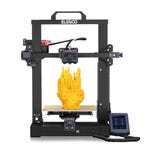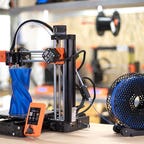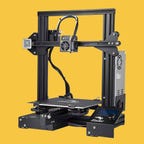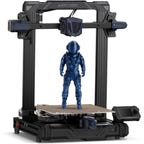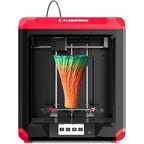 Why You Can Trust CNET
Why You Can Trust CNET Best Budget 3D Printer: 8 Great Printers at a Price You'll Love
The best 3D printer is the one you can afford. These are printers to suit those on a tighter budget.
3D printing -- or additive manufacturing, to give it its technical name -- has been around for a long time now. It's a fun way to create models that can be practical or just for fun. You can print giant pieces of cosplay armor or small statues to give as gifts. You can even buy a few printers, open your own Etsy store and start a business that way.
It costs less than ever to get into 3D printing, with printers available for under $200. The catch is that these budget machines usually require some tweaking to get it right. You'll save money, but it's a rough-and-tumble way to get started. The best budget 3D printers have a healthy balance between cost and usability, so that's what we are looking at in this list.
These budget 3D printers all cost under $500 (though prices can drift a bit month to month), and some are better suited to beginners than others. Our list of picks for the best 3D printer overall covers a much wider range of choices, but these are excellent for getting started -- or for buying several at once. If you are thinking of creating a print farm, then buying several Neptune 3 printers from Eegoo is an excellent way to get started.
The Elegoo is one of my favorite ultracheap printers. When testing it, I kept expecting it to fail and it just didn't. It produced amazing results for the price, and continues to do so every time I use it. The latest update from the Neptune 2 to the Neptune 3 has added automatic bed leveling, making it the best choice for a budget printer. And because it's based on the popular Ender 3 (see below), it has a lot of mods available to make it even better.
The Mini Plus is one of the best small-footprint printers you can buy. It has everything you would expect from a Prusa machine: Auto bed leveling, crash detection and great print quality, all for under $450. Building it with my son gave us a lot of good insights into how a 3D printer works, and potentially how to fix one.
The Ender 3 is one of the bestselling 3D printers of all time. Its under-$200 price removes a huge barrier to entry for anyone looking to spend as little as possible for their first machine.
Its popularity means there is a huge community of people to help you get it set up and working -- it's not exactly plug-and-play -- and you may need to spend a fair amount of time tweaking the Ender 3 to get it to print well.
The latest entry-level printer from Anycubic is surprisingly good. It comes in kit form, which gives you a chance to learn a little bit more about the machine. While that makes the setup more complicated, printing is much easier with auto bed leveling, something I have never seen in a $200 printer. It makes everything easier, believe me.
If you're looking to get into 3D printing and want to learn what each of the parts does, this is a great way to find out.
I've recently been working with the Finder 3 and I'm impressed with the quality it was able to produce straight from the box. It is easy to set up and comes with a flexible build plate that you can replace the glass bed with. It makes it far easier to remove builds.
In my CNET torture test, the Finder 3 coped really well with overhangs, as well as the points of the towers. Ringing was minimal, though it did struggle with bridging.
Overall, the Finder 3 is a great printer for the price. It's perfect for a teacher in the classroom as the enclosure makes it stable, and the slicer can control multiple printers at once via Wi-Fi.
As Dan Ackerman said in his review of the Creality Ender 3 S1, "At $399, the S1 version of the Ender-3 is about $100 more than older versions but includes so many upgrades and quality of life features that it qualifies as a great beginner-friendly, plug-and-play printer."
It's also a great budget-friendly Direct Drive printer, making it easier to use for materials such as TPU.
Resin 3D printers for beginners
Most beginner printers use a plastic filament to create models, but there are plenty of affordable resin 3D printers, too. Liquid resin is a little more difficult to use than standard 3D printing material and requires safety equipment. But it also produces amazingly detailed results.
This small resin printer is Elegoo's latest model in its popular Mars line. Because of the 4K monochrome LCD (these printers use light from an LCD to cure liquid resin) it can print much faster than older printers. The level of detail on models is something that standard 3D printing simply can't reproduce. At this price, the Elegoo Mars 3 is the best resin printer for the money.
This is expensive for a budget printer, but well worth it if you want a large enough print area to make something special. I have been using this as my main resin printer and it can handle anything I throw at it, from a D&D miniature army to highly detailed sculptures.
Frequently asked questions
What material should I use to print with?
Most home 3D printers use PLA or ABS plastic. Professional printers can use all sorts of materials, from metal to organic filament. Some printers use a liquid resin, which is much more difficult to handle but offers sharper details. As a beginner, use PLA. It's non-toxic, made mostly of cornstarch and sugarcane, handles easily, and is inexpensive. However, it's more sensitive to heat, so don't leave your 3D prints on the dashboard of a car on a hot day.
What settings should I use?
Most 3D printers include or link to recommended software, which can handle converting 3D STL or other files into formats supported by the printer. Stick with the suggested presets to start, with one exception. I've started adding a raft, or bottom layer of filament, to nearly everything I print. It has cut down dramatically on prints that don't adhere to the bed properly, which is a common issue. If you continue to have problems, rub a standard glue stick on the print bed right before printing.
What are supports?
Your 3D models probably need some help to print properly, as these printers don't do well with big overhangs -- for example, an arm sticking out from a figure. Your 3D printer software can usually automatically calculate and add supports, meaning little stands that hold up all those sticking-out parts of the model. After the print is done, clip the supports off with micro cutters and file down any nubs or rough edges with hobby files.
How we test
Testing 3D printers is an in-depth process. Printers often don't use the same materials, or even the same process to create models. I test SLA, 3D printers that use resin and light to print, and FDM, printers that melt plastic onto a plate. Each has a unique methodology. Core qualifiers I look at include:
- Hardware quality
- Ease of setup
- Bundled software
- Appearance and accuracy of prints
- Repairability
- Company and community support
A key test print, representing the (now old) CNET logo, is used to assess how a printer bridges gaps, creates accurate shapes and deals with overhangs. It even has little towers to help measure how well the 3D printer deals with temperature ranges.
Testing resin requires different criteria so I use the Ameralabs standard test -- printing out a small resin model that looks like a tiny town. This helps determine how accurate the printer is, how it deals with small parts and how well the UV exposure works at different points in the model.
Many other anecdotal test prints, using different 3D models, are also run on each printer to test the longevity of the parts and how well the machine copes with various shapes.
For the other criteria, I research the company to see how well it responds to support queries from customers and how easy it is to order replacement parts and install them yourself. Kits (printers that come only semi-assembled) are judged by how long, and how difficult, the assembly process is.


